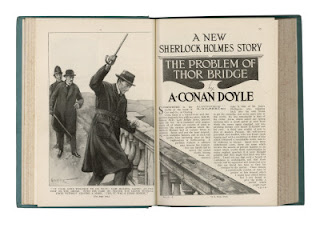“The Great Detective”
Sir Arthur Conan Doyle
Born on 22nd of May 1859 in Edinburgh Scotland of English and Irish parentage, Arthur Ignatius Conan Doyle was destined to be one of the worlds great writers.
Arthur's parents lived below the poverty line, with his father a reported alcoholic, his wealthy uncles supported Arthur and sent him to a Catholic preparatory school, followed by Stonyhurst College then a Jesuit school in Feldkirch, Austria.
Arthur also studied medicine at the University of Edinburgh. It was around this time he began writing short stories, one of which was published in 1879 “The Mystery of Sasassa Valley”, only a few months later his first non-fiction article was published in the British Medical Journal; “Gelsemium as a Poison”
Whilst his father was suffering at the hands of a psychiatric condition, Arthur sailed the world as a ship's surgeon on the SS Mayumba, it whilst on this voyage, he completed his doctorate on the subject of “tabes dorsalis” (1885), within a few more years his father had passed on from his illness.
In 1906 Arthur had a succession of deaths in his immediate family that affected him deeply. Firstly his much-beloved wife Louisa died, followed closely by the death of his son, his brother, his two brothers-in-law and then his two nephews.
Arthur became deeply depressed and sought refuge from his depression in the newly popular spiritualist movement that had flooded Great Britain.
Arthur became deeply depressed and sought refuge from his depression in the newly popular spiritualist movement that had flooded Great Britain.
Arthur became friends with various popular psychics and mediums, attending as many conferences and seances as he could, he became a member of both, “The Ghost Club” and “The Society For Psychical Research” and befriended illusionist Harry Houdini. In 1925 he opened “The Psychic Bookshop” in London.
Arthur’s investigations and research covered a wide range of topics, but his own personal experiences were few and far between.
He wrote in a book titled “The Whispering Ghost” in 1930 of a personal experience with “Old Hag Syndrome” a phenomenon often written off by today’s paranormal investigators as “sleep paralysis”.
 In the book Arthur tells of how he was facing a wall when he awoke and could not move, he could feel a “presence” in the room and that “The presence was not of this world”...
In the book Arthur tells of how he was facing a wall when he awoke and could not move, he could feel a “presence” in the room and that “The presence was not of this world”...
Arthur then describes how he heard footsteps approach him across the wood floor and a voice whisper “Doyle, I come to tell you that I am sorry”.
Arthur was convinced he knew who the phantom visitor was, but did not elaborate any further, other than to say “ It was a certain individual to whom I had tried to give some psychic consolation when he was bereaved. He rejected my advances with some contempt and died himself shortly afterwards. It may well be that he wished to express regret.”
From this intrusion into his bedtime habits, Arthur presented his theory that a spirit when materialising, needs to draw energy from a material source, and this is what rendered him unable to move whilst the entity was in his presence.
The Doyle family and two friends may have actually seen a ghost when the group set out one night to visit a church. The family and friends sat in the dark in an allegedly haunted Church where Arthur noted: “There was a dull haze of light, a sort of phosphorescent cloud, a foot or so across, and about a man's height from the ground”
The most famous of cases associated with Sir Arthur Conan Doyle was that of the “Cottingley Fairies”
Arthur was commissioned to write an article in 1920 for The Strand Magazine, an article about fairies for the Christmas issue. Arthur had learned of two photographs taken by Elsie Wright and Frances Griffiths, that pictured the girls with fairies in the garden. Arthur contacted the family and asked for permission to use the photographs for his feature. Impressed that the author of Sherlock Holmes, would consider the families photographs, they gave permission for publication.
The photos were inspected by experts at the Kodak company who stated they “could not find any evidence of the photos being faked” but, the company refused to offer a certificate of authenticity as their findings do not prove conclusively that the photos are genuine, just that they haven't been tampered with.
More can be read about Sir Arthur Conan Doyle's experiences and belief with the Cottingley fairies in his book “The Coming of the Fairies”
On the 7th of July 1930, Sir Arthur Conan Ignatius Doyle was found dead in his house in East Sussex, of a heart attack, his final words were to his wife “ You are Wonderful”.
After his death much controversy persisted, not being a “Christian”, but seeing himself as a “spiritualist” his body was buried in Windlesham Rose Garden, but later he was re-interred, with his Wife in Minstead Churchyard, Hampshire. The couple were buried outside the Churchyard, in unconsecrated ground.
With the graveyard being extended, the couple now lies amongst the newer graves.
The Epitaph on wooden plaques that are no longer accessible to the public reads: (in part):
“Blade straight
Steel true
Arthur Conan Doyle
Born May22nd 1859
Passed on 7th July 1930”
What is written upon the current headstone reads (in part);
“Steel true
Blade Straight
Arthur Conan Doyle
Knight
Patriot, Physician
and man of letters”
Researched and Written by
Allen Tiller © 2012
www.eidolonparanormal.com.au












.jpg)













.jpg)


